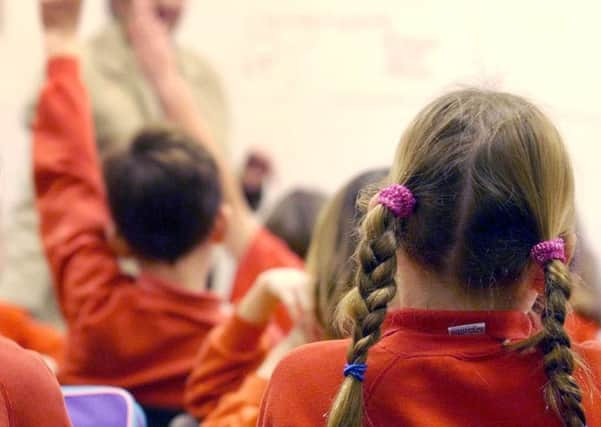Portsmouth schools celebrate GCSE success as government unveils latest performance data


Fifty-eight per cent of city pupils achieved A* to C grades in English and maths in last summer’s exams in a breakdown of official school attainment by the Department for Education.
Portsmouth Academy for Girls enjoyed the biggest improvement, with its proportion of students achieving the top grades in English and maths rising by 17 per cent compared to the year before.
Advertisement
Hide AdAdvertisement
Hide AdWhile St Edmund’s Catholic School saw a 13 per cent boost in achievement.
Portsmouth Tory education boss, Cllr Neill Young, said: ‘I’m pleased to see an overall improvement in results in these key areas and appreciate the efforts of teachers, school leaders, pupils and parents alike in achieving this. ‘As a council, we remain committed to working with the Regional Schools Commissioner and academies in the city to drive up education standards across the city and to supporting our schools and academies to help their students succeed.’
From this year, the government has decided not to judge schools based on whether students achieved five A* to C grades across subjects, including English and maths.
Instead, a new ‘Progress 8’ measure has been introduced - which assesses the progress of pupils across a selected set of eight subjects.
Advertisement
Hide AdAdvertisement
Hide AdThe DfE says Progress 8 is ‘fairer’ than the previous measure because it takes prior attainment into account and recognises ‘the achievements of all pupils not just those on the C/D borderline.’
Yet nationally the figures show that one in 10 secondary schools, collectively teaching more than 200,000 children, are under-performing.
Under the new Attainment 8 system students in the Hampshire County Council education area achieved a score of 51.1, performing above the national average of 49.9. This means that the average grade attained by Hampshire students was the equivalent of a grade C whereas the national average was a grade D.
Students studying for the English Baccalaureate (EBacc) also performed above the national average, with 25.9 per cent of students achieving the suite of qualifications against 24.6 per cent nationally.
Advertisement
Hide AdAdvertisement
Hide AdHampshire County Council’s executive member for education, Councillor Peter Edgar said: ‘I am delighted that the results from the Department for Education, reaffirm the academic success of our students - in spite of the change of how a school’s performance is measured. Their achievements are testament to their hard work, as well as the top quality education provided here in Hampshire.’
Statistics show nearly 300 secondaries in England are falling below the new government floor target that measures pupils’ progress and achievement over eight GCSE subjects.
Analysis of the DfE data reveals huge differences in children’s access to a good secondary school, an issue that is likely to fuel fresh debate about under-performance in some parts of the country.
Headteachers warned that the results had been achieved ‘against a national backdrop of a funding and recruitment crisis’.
Advertisement
Hide AdAdvertisement
Hide AdOverall, 282 secondaries, educating 206,991 children, have fallen under the government’s floor standard based on this new measure. This is around 9.3 per cent of secondaries.
Schools that are considered under-performing face intervention, and could be taken over.
In 2015, under the old five A*-C system, 329 schools - 11 per cent - were below the target.
School Standards minister, Nick Gibb, said: ‘Today’s figures confirm that the hard work of teachers and pupils across the country is leading to higher standards, and for that they should be congratulated.
Advertisement
Hide AdAdvertisement
Hide Ad‘As well as confirming that the number of young people taking GCSEs in core academic subjects is rising, today’s figures show the attainment gap between disadvantaged and all other pupils has now narrowed by seven per cent since 2011.
‘Under our reforms, there are almost 1.8m more young people in good or outstanding schools than in 2010, and through our new, fairer Progress 8 measure we will ensure that even more children are supported to achieve their full potential.’
Nationally, the data shows that both converter academies and selective schools made above the average progress in 2016.
The gap between disadvantaged pupils and others narrowed, and since 2011 has narrowed by 7 per cent.
Advertisement
Hide AdAdvertisement
Hide AdThe average Progress 8 score for disadvantaged pupils in grammar schools was 0.13, compared with a Progress 8 score of -0.32 for disadvantaged pupils in all state-funded mainstream schools.
Malcolm Trobe, interim general secretary of the Association of School and College Leaders, said: ‘Congratulations to schools and pupils on these results, which have been achieved against a national backdrop of a funding and recruitment crisis.
‘Progress 8 is a fairer measure of school performance than the old measure of the proportion of pupils achieving at least five A* to C grades at GCSE including English and maths.
‘It better reflects the fact that children start their secondary school education at different levels of academic ability and it aims to judge schools on the progress that all their pupils make, rather than an arbitrary measure of GCSE attainment.
Advertisement
Hide AdAdvertisement
Hide Ad‘However, Progress 8 has teething problems, and must be treated with some caution. Its biggest weakness is that the score of a school is disproportionately affected by as few as one or two pupils recording anomalous results.
‘We are aware of cases where Progress 8 scores have been badly affected by the fact that a very small number of vulnerable children have missed exams as a result of illnesses or other personal crises.’